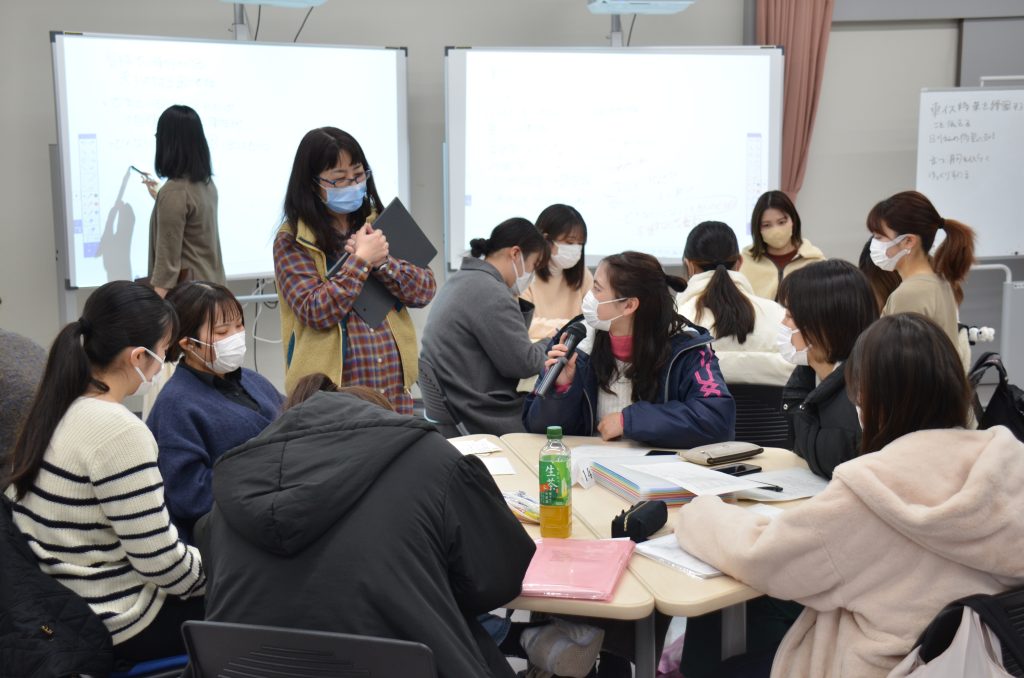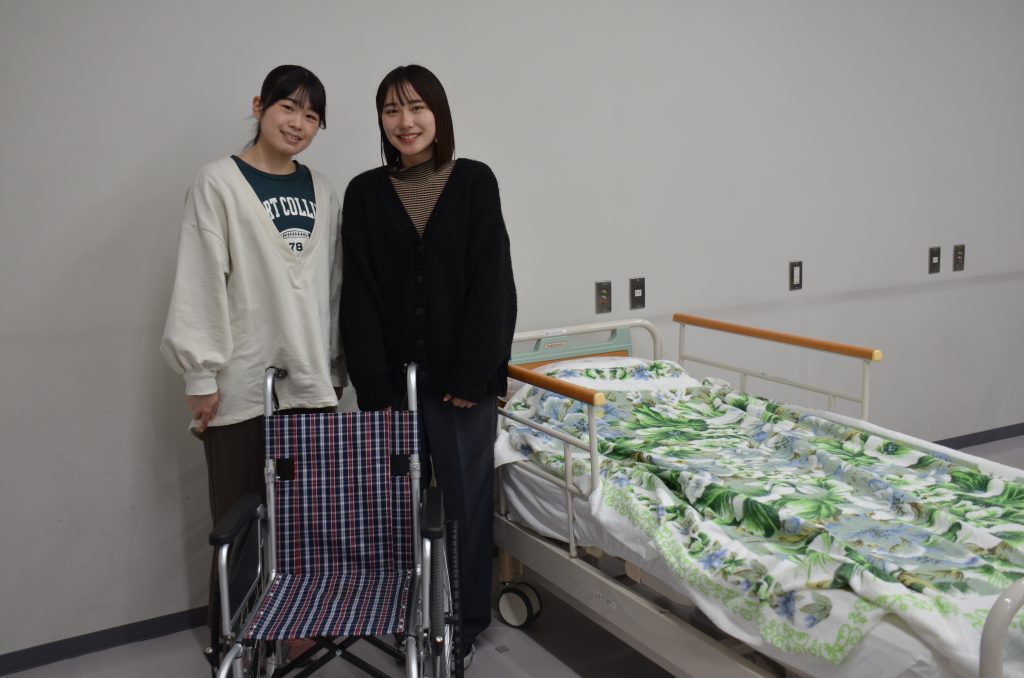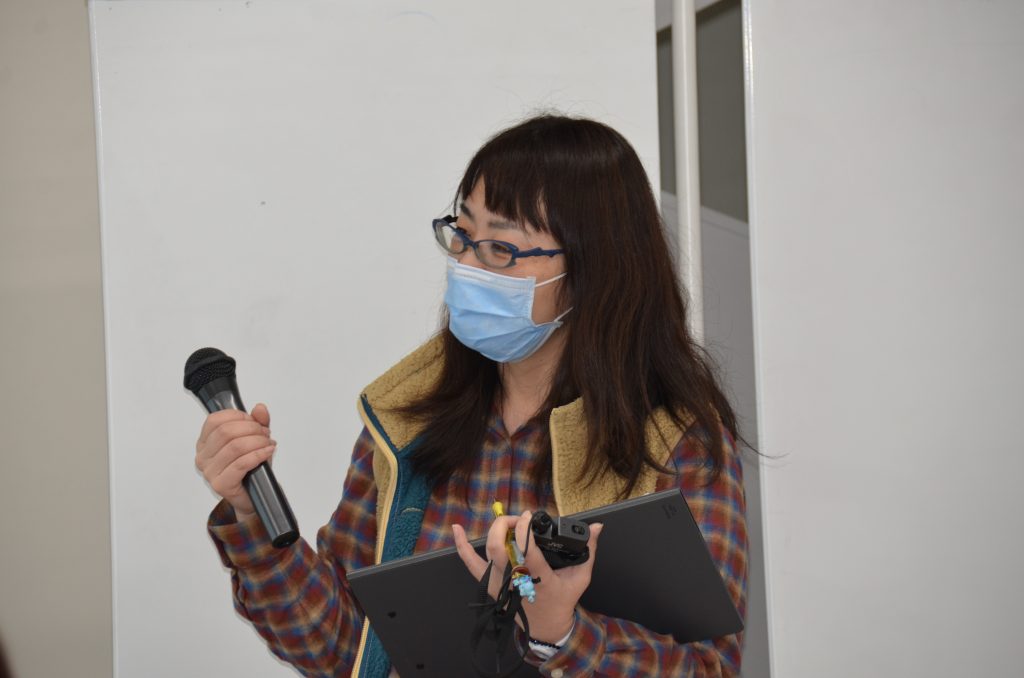The purpose of this class is to develop a thought process that relates health issues to a person’s way of life, living environment, and community characteristics and social resources in order to practice nursing that addresses health issues through an ongoing view of health and living. Throughout the 15 lessons, an 81-year-old woman is set as a model,
(1) The stage of maintaining and improving health where the person has knee pain but is still living at home.
(2) A stage of rapid health breakdown in which the knee condition worsens and surgery is required.
3) Stages of recovery to health requiring rehabilitation
(4) The stage of returning home again and acquiring a life at home
The course proceeds with the following. In this class, the nursing process is developed for each health stage, and there are distinctive ways of thinking for each health stage. In the stage of restoration of health (3) above, we used the concept of “goal-oriented thinking” to develop a nursing plan.
The class we interviewed was a scene from the practice of that nursing plan.
Lesson Content
The class included a simulation of the content of the nursing plan discussed by each group on “Nursing Care of People in the Recovery to Health Stage (Improvement of Standing and Walking Function). As the goal of the study,
(1) Obtain consent from the patient to transfer to a wheelchair
(2) Be able to explain the correct transfer procedure
(iii) Able to assist in transferring to a new location independently.
was raised.
In the simulation, an 81-year-old woman who had undergone left knee replacement surgery and was in a recovery hospital after acute treatment was used as the model, The students were practicing their own ideas of nursing care, such as how to increase opportunities for patients who tend to lie in bed to transfer to a wheelchair, how to talk to them to help them transfer safely, and how to support them to transfer. One was to ask the patient to transfer to a wheelchair and move to the dining room for meals. When we suggested that the patient move 30 minutes earlier than usual, we discussed how to respond to the patient’s reluctance to accept getting up and how to explain the correct procedure for transferring to a wheelchair while praising the patient for being able to do so. The simulation was conducted with a variety of creative ideas, such as motivating patients by explaining the correct procedure for transferring them to a wheelchair and praising them for doing so.


After the simulation, the facilitator asked questions to the students who had practiced the transfer, such as “What were you conscious of when encouraging the transfer to the wheelchair,” “What did you pay attention to during the transfer,” and “What did you think of the practice? The students who practiced the wheelchair transfer and all the students who observed the wheelchair transfer reflected on the experience. The students commented that they could not follow the nursing plan when dealing with actual people. Faculty members who played the role of patients commented, “I was happy when I was praised for what I was able to do during the transfer operation,” and “It would be nice if they could understand my pain better. Finally, the facilitator commented that she hoped that the participants would brush up their nursing plans further and become more flexible based on their actual experience with voice calls and nursing/support.
In this class, students can learn the process of reviewing nursing plans based on their findings and reflections through simulation and review of nursing plans reviewed and created by each group, leading to the implementation of nursing care and support tailored to each patient. As the person in charge of conducting the interview, I felt that if patients were supported based on a nursing plan that suited them, rather than a uniform nursing plan, they would be able to go through treatment and rehabilitation with peace of mind, and I thought that this class would help them learn this process.
Comments from faculty
This class is part of the Support for Living by Health Issues subject group. The subject of nursing is not limited to people with illnesses. In addition to survival and activity, emphasis is placed on living in society, and people are considered as living people, and those living people are the subjects of nursing. With this in mind, this subject is developed so that a certain woman living in a mountainous area can learn the thought process of nursing that is characteristic of each stage of her health as it changes.
In the past, the nursing process exercises mainly focused on developing a nursing plan, but this year we have added the implementation and evaluation of the nursing plan. By practicing the nursing plan that we developed as a group, we will learn how to explain to the patient, how to choose the right words, and what to do if the patient does not respond as we imagined. In addition, the nursing process is not only about implementation, but also about evaluation. You will evaluate what you have done and how the subject reacted to it, and consider whether there is a need to revise the plan. In this class, you will develop a series of nursing processes such as assessment, nursing diagnosis, nursing plan, nursing implementation, and evaluation, which will lead to the health issue-specific nursing practice that will begin in the first semester of the third year.
Comments from students
Miki Ikeda, 2nd year student, School of Medicine, Nursing
Through this class, you will be able to assess the subject, plan, and simulate the actual patient care, and realize what you need to pay attention to and what issues need to be addressed during implementation, which you could not notice during the planning stage. It also allows us to realize that when we are in contact with actual patients, things do not always go as planned in advance. By gaining these insights, we can find the next goals and issues regarding the subject’s functional recovery, which will lead to better and more individualized planning tailored to the subject.
Mao Hayashikoshi, 2nd Year Student, School of Medicine, Nursing
In this class, we have used the case of one patient to consider the support needed at all stages. By developing the nursing process of one patient’s deterioration, surgery, and recovery, we were able to grasp the flow of the nursing process and understand that checking whether we have all the information we really need, whether there is any waste, and whether it is appropriate will lead to appropriate assessments. In addition, by exchanging opinions in the group based on what we had thought about in our self-study, we realized what we were not doing well and what we needed to strengthen, which motivated us to study further. The professors also clearly explained to us what the purpose of the case study exercise was, which motivated us to learn and think for ourselves. Through this class, I was able to understand why we need to learn the nursing process, what are the benefits of learning the nursing process, and the meaning and advantages of the nursing process, and I was able to grasp the key points in each area. In the future, I will be working with patients whose conditions are not always the same in my practice, and I would like to make the most of what I have learned in this class without being sad or confused.



